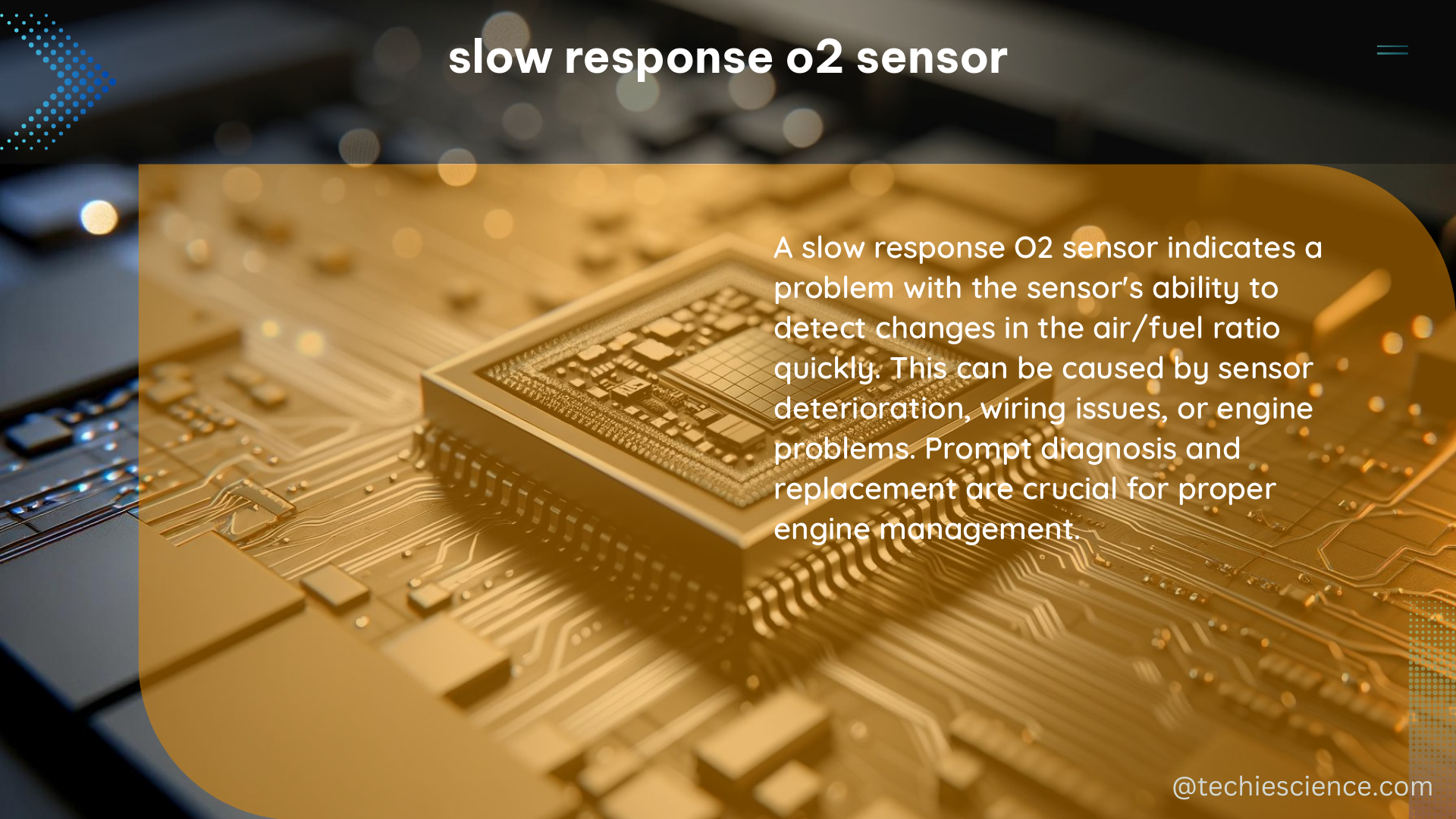Slow response oxygen (O2) sensors, also known as heated oxygen sensors, are crucial components in modern vehicles’ exhaust systems. They provide real-time data on the air-fuel ratio in the engine, enabling the engine control unit (ECU) to adjust the mixture for optimal performance and emissions. Over time, these sensors can degrade or become less responsive, leading to issues such as slow response O2 sensor codes (e.g., P0139) and poor engine performance.
Technical Specifications of Slow Response O2 Sensors
- Heat-up Time:
- Slow response O2 sensors typically take longer to heat up compared to their fast-response counterparts.
- This is because they are designed to operate at higher temperatures (around 600°C) to improve their sensitivity and response time.
-
The heat-up time can vary depending on the sensor design, but it is generally in the range of 30-60 seconds.
-
Response Time:
- Slow response O2 sensors have a slower response time compared to fast-response sensors.
- They usually take several seconds (typically 2-5 seconds) to reach 90% of their final voltage output after a step change in the air-fuel ratio.
-
In contrast, fast-response O2 sensors can reach 90% of their final voltage output in less than 100 milliseconds.
-
Voltage Output:
- Slow response O2 sensors produce a voltage output that ranges from approximately 0.1 to 0.9 volts, depending on the air-fuel ratio.
- A rich mixture (low oxygen content) produces a higher voltage, while a lean mixture (high oxygen content) produces a lower voltage.
-
The voltage output is typically measured in millivolts (mV), with a range of 100-900 mV.
-
Location:
- Slow response O2 sensors are typically located after the catalytic converter in the exhaust system.
- This placement allows them to monitor the efficiency of the converter and provide feedback to the ECU for emissions control.
-
The sensor is usually positioned in the exhaust pipe, approximately 12-18 inches downstream from the catalytic converter.
-
Lifespan:
- The lifespan of a slow response O2 sensor can vary, but they typically last between 30,000 and 100,000 miles.
- The actual lifespan depends on factors such as the vehicle, driving conditions, and maintenance practices.
- Regular vehicle maintenance, including timely oil changes and exhaust system inspections, can help extend the lifespan of these sensors.
Diagnosing and Resolving Slow Response O2 Sensor Issues

- Visual Inspection:
- Carefully inspect the O2 sensor and its surrounding components for any signs of damage, corrosion, or loose connections.
- Look for physical damage to the sensor, such as cracks, discoloration, or signs of overheating.
-
Check the wiring harness and connectors for any signs of wear or damage.
-
Exhaust Leak Check:
- Examine the exhaust system for any leaks, especially between the engine and the O2 sensor.
- Leaks can allow extra oxygen into the exhaust, skewing the sensor’s readings and causing slow response.
-
Use a smoke machine or other leak detection method to identify and address any exhaust leaks.
-
O2 Sensor Performance Testing:
- Use a scan tool or multimeter to monitor the sensor’s output in real-time.
- A healthy slow response O2 sensor should show a fluctuating voltage that responds quickly to changes in engine load.
-
If the sensor’s voltage output is sluggish or unresponsive, it may indicate a problem with the sensor.
-
Sensor Replacement:
- If the O2 sensor is found to be faulty, replace it with a new one that matches your vehicle model and engine type.
- Ensure that the replacement sensor is compatible with your vehicle’s electrical system and exhaust configuration.
-
Follow the manufacturer’s instructions for proper installation and calibration of the new sensor.
-
ECU Check:
- In rare cases, the issue may lie with the vehicle’s ECU rather than the O2 sensor itself.
- If the sensor and exhaust system are in good condition and functioning correctly, consult a professional to examine the ECU for any software or hardware issues.
- The ECU may need to be reprogrammed or replaced if it is not properly processing the O2 sensor data.
Additional Resources
For more in-depth information on slow response O2 sensors, consider the following resources:
- Response time correction of slow response sensor data by deconvolution of the growth-law equation
- What can cause slow oxygen sensor readings?
- Fixing P0139 O2 Sensor Slow Response Guide – Mavyn
These resources provide valuable insights into the technical aspects of slow response O2 sensors, as well as practical advice for diagnosing and addressing issues related to these sensors.
Reference:
- Response time correction of slow response sensor data by deconvolution of the growth-law equation
- What can cause slow oxygen sensor readings?
- Fixing P0139 O2 Sensor Slow Response Guide – Mavyn

The lambdageeks.com Core SME Team is a group of experienced subject matter experts from diverse scientific and technical fields including Physics, Chemistry, Technology,Electronics & Electrical Engineering, Automotive, Mechanical Engineering. Our team collaborates to create high-quality, well-researched articles on a wide range of science and technology topics for the lambdageeks.com website.
All Our Senior SME are having more than 7 Years of experience in the respective fields . They are either Working Industry Professionals or assocaited With different Universities. Refer Our Authors Page to get to know About our Core SMEs.